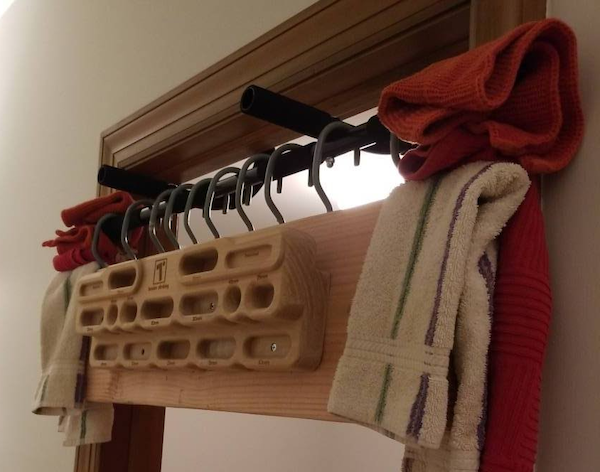If you’ve browsed the adventure section of my website you know I’m a climber. Currently, the climbing gyms in Chicago are closed due to COVID-19 concerns. This has put a damper on my training but I own a hangboard and have been able to keep training my fingers at home.
A hangboard allows you to apply stress to your fingers in a measured and controlled fashion. It is a vital tool for a climber who is serious about getting stronger. It is also a great rehab tool for coming back from injuries.
Below is my hangboard.

As you can see from the photo, I’ve hung mine using a doorway pull-up bar and a bunch of hooks. This lets me easily take it down and causes no permanent damage to anything in my apartment. The towels are there to make sure the door frame isn’t crushed by any of the hard pieces.
Originally, I followed this video to mount it using some pipe and shoving the pipe into the pull-up bar. This setup made me uncomfortable as the forces on the pull-up bar were far away from the intended location. This resulted in a lot of flexing and I was concerned about how the pull-up bar was acting on the frame.
I searched online for other ideas and saw a setup that used hooks. This was appealing to me as it moves your weight under the bar. A quick trip to Home Depot and a bit of easy construction and now I can keep up my finger strength when stuck at home. Here are the steps to build one.
- Buy a 2 inch x 10 inch wood board (or some other 2 inch x N inch board that is big enough for whatever you want to attach to it).
- Cut the board so it spans the width of your doorway plus a few extra inches. Home Depot can do this for you.
- Mount your hangboard to the board.
- Take hooks, typically used for hanging bicycles up in a garage, and screw them into the top of your 2-in x 10-in.
- Hang the hooks over the pull-up bar. Adjust the hooks so each is pulling on the bar.
- Find some padding, I used towels, and put the padding between the door trim and other hard surfaces.
- Hang on your hangboard and get stronger.
The board and hook method was much easier to construct than the other pull-up bar method and feels much more solid. The pull-up bar isn’t rated for too much weight, so I’m not going to do any super heavy, two-handed hangs but it is plenty solid for other hangboard exercises.
If you’re a climber and don’t want to permanently mount a handboard, I’d highly recommend this. If you don’t own a hangboard, I pick up something from Tension Climbing. Their wooden boards are easy on the finger tips and have all the edge sizes you’ll need.